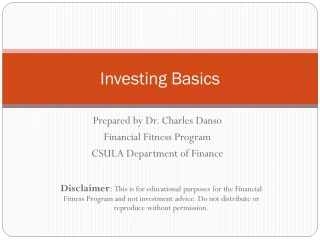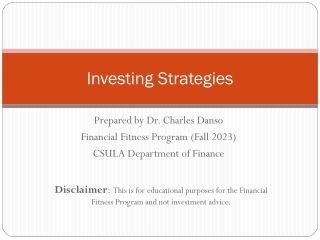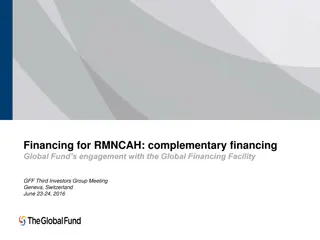Investing 2.0 - Investing Strategies
Different types of investing strategies, risk tolerance levels, and the psychology of investing in the Financial Fitness Program by Dr. Charles Danso. Understand the types of assets and learn how to make informed investment decisions.
Download Presentation

Please find below an Image/Link to download the presentation.
The content on the website is provided AS IS for your information and personal use only. It may not be sold, licensed, or shared on other websites without obtaining consent from the author.If you encounter any issues during the download, it is possible that the publisher has removed the file from their server.
You are allowed to download the files provided on this website for personal or commercial use, subject to the condition that they are used lawfully. All files are the property of their respective owners.
The content on the website is provided AS IS for your information and personal use only. It may not be sold, licensed, or shared on other websites without obtaining consent from the author.
E N D
Presentation Transcript
Investing 2.0- Investing Strategies Prepared by Dr. Charles Danso Financial Fitness Program (Fall 2022) CSULA Department of Finance Disclaimer: This is for educational purposes for the Financial Fitness Program and not investment advice.
What Is Your Reason for Investing Retirement Purchase Goal Job Income Replacement Income supplement Target purchases Savings (education goals, health accounts) Investing out of DESPERATION is not advisable. 2
Types of Investing Speculation: Hoping to profit investing in something but also expecting a probability and possibility of loss Hedging: To create certainty in investment outcome by taking an opposite position to offset losses Arbitrage: Taking advantage of market mispricing or imperfections to make profit Involves simultaneously buying and selling the same asset in mispriced markets (for example) NOTE: These are also the main motivation of investors you can find in a market as well as categorizations. 3
What is your risk Tolerance level Definition Risk Tolerance: Level of risk an investor is willing to take on vs. Risk Capacity: How much loss one can comfortably manage given present circumstances PASS Allocation Score by William Droms & Steven Strauss More commonly used by practitioners and advisors Using Questionnaires Some investment platforms already have some (read disclaimers) https://www.investright.org/informed-investing/know- yourself/test-your-risk-tolerance/ https://pfp.missouri.edu/research/investment-risk-tolerance- assessment/ 4
Risk Pyramid In Investing NOTE: There is potential to lose money in investing. Losses can be substantial. There is also no guarantee of gains or profits. 5
Psychology of Investing Role of emotions Fear Greed Desperation Behavioral Biases in investing (some) include: Overconfidence bias Familiarity bias Loss aversion Self-attribution bias, etc. 6
Types of Assets Discussed Stocks Bonds Derivatives Options Futures Forwards Swaps Alternative Investments Traditionally applied to investments outside of stocks & bonds Art, Jewelry, vintage, collector s items, antiques, etc. Real Estate 7
Investment Theories (for most assets) Fundamental Analysis Assume that a stock s intrinsic or real value is determined by the company s future earnings Fundamental analyses consider things such as: Expected earnings, Financial strength of the company, Type of industry company is in, New product development, Economic growth of the overall economy. Technical Analysis Based on the assumption that a stock s market value is determined by the forces of supply and demand in the stock market as a whole Deviates from fundamentalism by assuming that past market trends can predict the future direction for the market as a whole instead of fundamental value. Chartists plot past price movements and other market averages to observe trends they use to predict a stock s future value. Efficient Market Hypotheses (EMH) Based on the assumption that stock price movements are purely random. A stock s current market price reflects its true value (News??). It is impossible for an investor to outperform the average for the stock market as a whole over a long period of time unless they pick riskier investments (beta & Alpha) Behavioral theories adopted based on contrary evidence or observations (i.e. violations)
Tools of Technical Analyses Using Charts: Plotting historical prices to determine pattern, and using moving averages. Trends such as support vs resistance. Market Volume: market volume along with direction of market movement captures investor sentiment Linked to investor sentiment in behavioral finance Short Interest: provides insight into future demand for a stock. E.g. large short positions need to be bought and indicate built up demand. Linked to Contrarian strategy in behavioral finance Odd Lot Trading: Taking the opposite trades of retail investors who trade less than 100 shares Linked to contrarian strategy in Behavioral finance Dow Theory: A signal but not predictor of an end to bull or bear markets. Foundational series of writing that gave birth to tenets in technical analyses Breadth of the Market: Measure of number of stocks increasing in value versus the opposite. Somewhat linked to momentum trading in behavioral finance Advance Decline Line: difference between number of stocks that closed up versus those that lost value
Some Investment Strategies SHORT-TERM ORIENTED TECHNIQUES. Day Trading (buying/Selling within a trading day) Buying on Margin (using borrowed money). Selling Short Borrowing stock, selling & holding cash o Return stock when bought at a lower price if stock price dips o The gain is obtained from the price sold versus the price bought after dip Pair trading: Holding offsetting positions in the same assets Trading using derivatives. Options, Futures, etc Trading Options solo or combining options with underlying assets in trading strategies LONG-TERM ORIENTED TECHNIQUES. Buy-and-Hold. Dollar Cost Averaging You can trade in these strategies actively or passively 10
Stocks (or Equity) Some Strategies (Based on expectations): - Buy when you expect stock to increase, - Short stock if you expect stock to decrease to gain profits 11
Stock Trading Strategies by investment theory Technical Analyses Odd Lots Trading Fundamental Analyses P/E Effect (exception to EMH) EMH Behavioral Dollar Cost averaging Contrarian (or reversal) Charting (resistance vs support) January Effect (exeption) Small Firm Effect (exception) Value Line Effect (Exception) Momentum 12
Types of Orders (Buy/Sell) Transactions Market order: Request to buy or sell stock immediately (at market value now) Used when speed is preferred to than price Limit order: Request to buy or sell a stock at a specified price or better. Used when price is more important than speed of trade Stop-loss order (or stop order): To limit loss Request to buy or sell a stock after it reaches a specified price Then after that that, it trades at next chance (i.e. market order) E.g. sell a stock if it drops from $15 to $10, then sell at the market rate that exists once the price drops to $10 Stop-Limit Order: Combines a Stop with a limit order Once a stop price is reached, converts to a limit order/price E.g. Stock Price is $35, a stop order is placed at $28 to sell if it reaches that price. Then a limit is placed at $24 (i.e. sell only at $24 or above) Trailing Stop Order: Similar to stop order but based on percentage change in market price E.g. stock is bought at $30, but a trailing stop order is placed for 20%. Therefore stock would be sold when price reduces 20% or more. Can be applied to sales 13
Bonds (or Debt instruments) Bond Laddering: having bonds with different maturities With each bond maturity, investor buys new bonds than exist in portfolio Tax Swap: Taking loss from a bond and a profit from another bond May or may not offset each other Barbells: owning both long & short term bonds Selling one set with interest rate movements Bullets: Used when expecting a balloon payment in the future Little payments in the beginning, then receive a lump sum in the future. (e.g. Zero-Coupon bonds, etc) 14
Indexes & ETFs Index: A combination of stocks that track performances E.g. S&P 500 Index, Dow Jones Industrial Average, Russell 3000 Index Usually used as benchmarks for performances E.g. S&P500 for stocks & stock portfolios Exchange Traded Funds (ETFs) A traded equity/stock modeled after an index or portfolio (combination) of stocks, or commodity Can be an underlying index, sector commodity, or other asset, yet will trade like a stock on a stock exchange They are not actively managed by professionals unlike mutual funds Mutual funds have most of these features, but cannot be traded the way a stock can. Holding ETFs and indexing strategies are Passive trading strategies 15
Derivative Assets (Contracts) Derivative Contracts: A contract whose value comes from the underlying asset. Since these are contracts, they are legally binding Options Contract: PUT or CALL Confers the right BUT not obligation to buy (for CALL options) or sell (for PUT Options) the underlying asset at a given price at a point in the future. These are usually for financial instruments Futures Contracts Obligation to buy/sell underlying asset at a given price at a specific time in the future Done mostly for commodities, but can exist for securities Transactions are standardized in size Forward Contracts Customized between two parties to buy/sell underlying asset at a specific price at a given time in the future Mostly done for currencies (Forex) Derivative Contracts tend to be risky and complex Usually suggested to have some experience trading in other financial instruments (that act as underlying assets) before venturing into these areas You can use Paper/Virtual Trading to get some experience first with no risk 16
Options Trading Strategies Single Option Strategies Purchasing or selling calls Purchasing or Selling Put Options Combination Strategies Covered Call: Buy underlying asset and sell call option Married or protective Put: Buy underlying asset and buy put options Straddle (buying, i.e. long straddle or selling, i.e. short straddle) Buying a put and a call option with same expiration & strike price Goal is to profit regardless of the direction of the stock movement Profitable when price of underlying asset increases or decreases beyond cost of premium. Strangle (buying, i.e. long strangle or selling, i.e. short strangle) Buying a put and a call option with same expiration & different strike price Collar (i.e. protective put and covered call) If you bought underlying asset, buy a put and sell a call Used to prevent against large losses, but reduces large gains Option Spreads: Examples include Bull Call Spread , Bear Put Spread , Butterfly Spreads (combines Bull spreads with bear spreads) Other Strategies include, iron Condor , Protective Collar , 17
Futures Trading Strategies Taking Long position (i.e. Buying) Taking short position (i.e. selling) Calendar Spread: Buying & Selling contracts for the same underlying asset with different expiration dates Bull Calendar Spread Long (i.e. buy) short-term contract & short (i.e. sell) long-term contract Bear Calendar Spread Short (sell) the short term contract, & long (buy) the long-term contract 18
Investment Portfolio & Diversification Portfolio: Combination of financial investments Provides Diversification: Having different investments so your risk is not concentrated in one type of investment or asset. Reduces overall risk in a portfolio over time Stock Portfolio Combination of different stocks ONLY Reduces risk exposure to one or few stocks Bond Portfolio Combination of different bonds ONLY Reduces risk exposure to one or few stocks Investment Portfolio Combination of different investments such as stocks ,bonds, options Reduces risk exposure to one or few types of assets Note: Diversification does not allow highest return possible for a single asset. However, risks are spread among assets not correlated. 19
Mutual Fund Investment Strategies Indexing: Funds that follow indexes Style Investing: Funds that follow investment styles Aggressive Growth Midsize Exchange Traded Funds (ETFs): May follow a stocks, or commodities Focus investing: Funds have a specific focus Sector funds ESG (responsible or ethical) Funds Emerging Market Funds 20
Real Estate Investment Strategy Direct Real Estate Direct Real Estate The investor holds legal title to the property. Single-family dwellings. Duplexes. Apartments. Land. Commercial property. Indirect Real Estate Indirect Real Estate Investor appoints a trustee who holds legal title on behalf of all investors in the group. Limited partnerships Syndicates. Real estate investment trusts. Mortgages and mortgage pools. 21
Tax Implication of Trading Short Short- -Term Capital Gains Term Capital Gains Long Long- -Term Capital Gains Term Capital Gains Stocks held less than a year (ordinary income tax rate) Real Estate Stocks held more than a year (0%,15%, or 20%) Dividend income 22
Tax Implications in Retirement Assets Withdrawal Penalties Withdrawal Penalties Taxes To Expect Taxes To Expect Ordinary Income when withdrawals occur at retirement (except Roth) Ordinary income after withdrawal before retirement Required Minimum Distribution (RMD) Withdraw a % or govt taxes At age 72 govt starts taking money out if you have not withdrawn any money Typically 10% if withdrawn before retirement age 401(k) before 59.5years 403(b) before 59.5 years 457(b) No penalty IRA before 59.5 Roth IRA before 59.5 23
Questions??? 24























